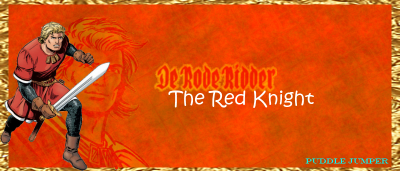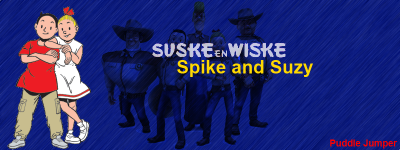Reading is something that I enjoy doing. There’s nothing quite like grabbing a book and engulfing yourself in the white oceans containing black lettered wildlife, immersing yourself in a world brought to life by not only the author’s imagination but yours as well. For many, many years now, my evening routine exists of picking up a book and reading until my eyes grow tired. I’ve read many books over the years and I’m damned proud of that fact.
However, if there’s one thing I’ve noticed, I always tend to go back to my roots. The first books that I ever read were comic books. From there I ventured forth in to the world of books. But comic books is where it all began for me. Whenever I feel down, I tend to go back to my trusty ol’ comics and read up on adventures of years ago.
It’s not uncommon for people on the internet to associate comics with the superhero comics from America. You know, the ones with them flashy costumes and the ridiculous names. Not here though. No, sir. Over here in Belgium, we don’t even have superhero comics. Well, now we have a comic of a TV series for kids but that doesn’t really count.
The kind of comic books that I grew up with are strips. Comics tend to exist in a larger universe like the Marvel universe. Plus, it’s not uncommon for a story in comics to span over several issues and even several titles. Strips on the other hand are most commonly stories on their own with little to no connection to other stories. Plus, as I mentioned before, strips aren’t usually superhero related. Here in Belgium we have several strip series like Kiekeboe, about the Kiekeboe family but Marcel Kiekeboe in particular. There’s also Jommeke, a boy and his friends; Nero, a family man; Urbanus, a boy and his family. And there’s many others like them.
Today I’m here to talk to you about one man in particular. He is the godfather of Belgian strips. A legend in his own rights and a man who has brought Belgium countless of series that are made out of pure win. This man is our Stan Lee. He might not have created comics like Spider-man or Captain America or The Fantastic Four, but he has been entertaining us since 1945 none the less. Now, 20 years after his death, his creations are still entertaining us albeit made by different hands. He is:
Willy Vandersteen
However, if there’s one thing I’ve noticed, I always tend to go back to my roots. The first books that I ever read were comic books. From there I ventured forth in to the world of books. But comic books is where it all began for me. Whenever I feel down, I tend to go back to my trusty ol’ comics and read up on adventures of years ago.
It’s not uncommon for people on the internet to associate comics with the superhero comics from America. You know, the ones with them flashy costumes and the ridiculous names. Not here though. No, sir. Over here in Belgium, we don’t even have superhero comics. Well, now we have a comic of a TV series for kids but that doesn’t really count.
The kind of comic books that I grew up with are strips. Comics tend to exist in a larger universe like the Marvel universe. Plus, it’s not uncommon for a story in comics to span over several issues and even several titles. Strips on the other hand are most commonly stories on their own with little to no connection to other stories. Plus, as I mentioned before, strips aren’t usually superhero related. Here in Belgium we have several strip series like Kiekeboe, about the Kiekeboe family but Marcel Kiekeboe in particular. There’s also Jommeke, a boy and his friends; Nero, a family man; Urbanus, a boy and his family. And there’s many others like them.
Today I’m here to talk to you about one man in particular. He is the godfather of Belgian strips. A legend in his own rights and a man who has brought Belgium countless of series that are made out of pure win. This man is our Stan Lee. He might not have created comics like Spider-man or Captain America or The Fantastic Four, but he has been entertaining us since 1945 none the less. Now, 20 years after his death, his creations are still entertaining us albeit made by different hands. He is:
Willy Vandersteen
Born on the Stuivenbergplein, Vandersteen was raised in an Antwerp neighborhood known as De Seefhoek. During his childhood, Vandersteen was often blamed for having interest for only drawing and writing essays. With a family of laborers, Vandersteen first went in to carpentry, after which he decided to go in to decorating. Whilst decorating a shopping window one day, Vandersteen was asked to draw a model out of an American magazine on to panel. Going through the article paired with said picture of the model, he first learnt of strip making. That was when his interest was piqued.
The man created many series including Bessy, a wild west story about the dog named Bessy and her owner. There was also Robert and Bertrand, a series set in the 19th century in France. Safari, a story set in Africa surrounding the hunter Sam Burton, a Masaï warrior named Mgono and the archeologist Ellen Moore and her son. One of his creations was based off of a main character of a children’s novel series. This was De Rode Ridder, or The Red Knight.

Johan, known as The Red Knight because of his tunic, was a simple warrior who attained the title of knighthood because of his actions in and outside of battle. Loyal to the church and the king, Johan travels the lands to help the weak, the needy and the oppressed. Johan is a Flemish knight who has traveled all over the world to loan his services to those that require it. Eventually even, the man offered his blade to King Arthur himself, becoming best friends with Lancelot and an acquaintance of the great wizard Merlin. Throughout his many adventures, Johan even befriends other famous historic characters like The Lion of Flanders.
All in all, the series is quite solid, even today. Like many comics from Belgium, the story tends to go at a rapid pace, going over large events in but a few panels. Yet, that doesn’t seem to be all too bothersome in the end as the overall package is satisfying to read. The artwork is excellent all around though I’ve never really been a big fan of Johan’s ugly mug. Luckily he isn’t clumsy to boot.
This series started, not in black and white, but in red and white. These issues are known as the blue editions and are no longer available, as the grey editions (the colored ones) are the only ones being reprinted. Like Largo Winch and XIII, these strips come in an A4 format with a cardboard cover.
All of these comics wouldn’t have been possible however if it wasn’t for his most famous series ever. A series that has evolved far beyond it’s paper origins, stretching as far as live action movies, animated movies, a TV-series, games and much, much more. It even spawned one or two spin-off series. I’m of course talking about the strip that started it all: Suske en Wiske, or Spike and Suzy

On March 30th of 1945, De Nieuwe Standaard (a newspaper) first published The Adventures of Rikki and Wiske. This was a story known as Rikki and Wiske in Chocowakije, a fictional nation created by Vandersteen. However, Rikki proved to be too similar to Tin-Tin and thus he created Suske. Rikki was Wiske’s older brother and Suske was a boy of about Wiske’s age. On December 19th, Suske made his first appearance in The Island of Amoras, another fictional nation. There from the start was Wiske’s aunt Sidonia. Other main characters followed soon after. Them being Professor Barabas, a genius inventor of a time machine, a sentient car and more, Lambik, a man of about Sidonia’s age and then there’s Jerom, a cave-man brought to the future via a time machine.
The charm of this strip lies in its characters above anything else. Each character is unique in their own way and bring with them a rich history and a deep personality. You can really tell that there has been a lot of thought to these characters and it really pushes the series to a new level.
Besides the characters, the series also has phenomenal stories that take place in all times and places. The stories come from all over. From local folklore to actuality. One issue, the family could find themselves in an amusement park with fairy tales as a theme that’s actually magic whilst in the next issue they could be in Sicily in an adventure with the mafia, no kidding. There’s even an issue named Big Mother, a throw at the Big Brother reality series. Issues that I found to be amusing as well were Robotcop, Jeromba the greek, De crazy Musketeers and others. These stories are a throw on familiar stories, bringing their charm to the stories. It’s kind of awesome in the end.
Throughout the series, there are a lot of different jokes going from running gags to … well, actual jokes. Most of them tend to be very humerous and manage to give us a chuckle. Unfortunately, as Paul Geerts passed along the torch to a new team, the series went downhill. The jokes are either predictable, lame or even forced in. Many times, the humor seems to be shoehorned in even.
Like The Red Knight, Suske and Wiske’s stories tended to be rushed at first. Once the series got in to Paul Geerts’ hands, it became more detailed and rich in panels. The art was horrendous in the beginning. I never really liked the first issues. However, it didn’t take too long for it to evolve and become quite good actually. The day of today, the art is actually very detailed and very rich in details.
Willy Vandersteen paved the way for almost all of the strip authors of Belgium today. Many of these series wouldn’t even exist if it weren’t for this man. His stories entertain not only the youth, but older generations as well. There’s enough in these stories to entertain everyone. Whilst the overall tone of these series are light, they can be dark as well at times. Unlike Captain Planet, whenever these stories dive in to touchy subjects, the writers handle it with care and do a dang good job.
If you ever find yourself a translated copy of any of Willy Vandersteen’s works, pick it up. I promise you, you won’t regret it.

No comments:
Post a Comment